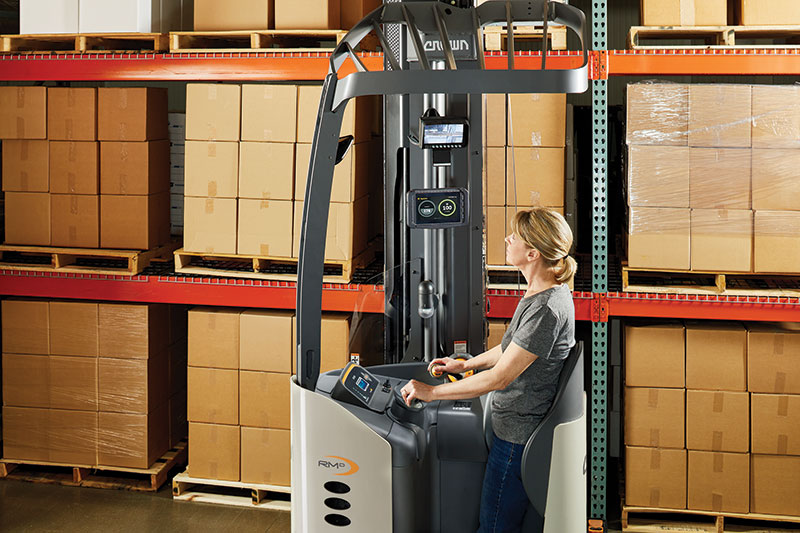Get a fuller picture of your fleet
转载 2021-04-14 09:54 Roberto Michel Source:MMHAdvancements in lift truck telematics and fleet software can help fleet managers keep a close eye on hours of use and task environment.
here is big difference between recording data for lift truck fleet management and digitizing the fleet management process. Paper-based or spreadsheet methods might work for a small operation, but they don’t provide a full picture for fleet management, points out Jim Gaskell, director of global automation and emerging technologies at Crown.
By combining data from WMS on production throughput with telematics-generated data on how each unit is being used, richer data for fleet management can feed into analytics dashboards.
“If you only have one part of the picture, like how much was spent on repairs for a truck, the problem is you might be spending several thousand on one asset, but you don’t know how many hours of use it’s seeing or how harsh the environment is,” says Gaskell. “Without knowing factors like hours of use and task environment, it’s hard to look a repair cost figures and draw too many conclusions from it.”
Here’s where advancements in lift truck telematics and fleet software can help, along with analytics dashboards in fleet software that bring different data together, possibly including data from a warehouse management system (WMS), which gives insight on the tasks and productivity generated by the fleet and its operators.
To properly manage a fleet, it helps to have accurate, online data on repair events and costs, hour meter and usage data collected automatically from each lift truck, and insight into tasks a particular truck is being used for.
“If you take 10 lift trucks in a fleet, those repair costs are going to vary, and one unit might show a cost that is maybe 50% higher than the others,” Gaskell says. “But if you want to truly understand why those costs are higher, you’d want to know how many hours that truck is being used and the harshness of the environment.”
For example, some lift trucks might get used for loading rail cars, involving ramps, uneven surfaces and tight spaces, so it might make sense that a lift truck used for rail car loading shows higher repair costs than similar units used elsewhere. “When you combine telematics with fleet software, you can see all the factors involved and get answers to what is driving your costs, and how to manage those costs more effectively,” says Gaskell.
Data from a WMS will allow for fleet productivity insights down to pallets per hour an operator/truck is generating. “When you have accurate repair data and usage data, and productivity metrics—when you pull that all together in fleet software, that is the triangle of information you want to have,” says Gaskell.
Fleet software functions such as lift truck operator notes on potential vehicle problems can trigger alerts to supervisors and maintenance staff so any issues get addressed in a digital workflow, rather than relying on verbal communication or paper reports or notes.
Even as something as seemingly straightforward as recording hour meter data from lift trucks is more accurate with telematics because it’s a real-time digital reading coming from the lift truck’s electronics, rather than a reading entered by a technician, which, like any data entry, is prone to error.
“The digital aspect of having telematics ensures that meter readings are accurate, and that anything that needs to be checked out with a unit gets done,” says Gaskell.
Telematics also monitors other meter data straight from a lift truck’s electronics, such as hours a unit is traveling or time spent lifting. This data stream allows for deeper analysis of how each unit is used, and can be used to spot anomalies versus similar units. Users of fleet software can configure a dashboard with the metrics they want, and some get more detailed in pulling in productivity-related data from WMS.
“Some users, especially third-party logistics providers or users in industry like grocery, leverage fleet software to have a detailed view of productivity, down to the cost per pallet, per hour, to really understand the costs of their operation or in serving their clients. But any operation can benefit from having a fuller picture of how their fleet is performing,” adds Gaskell.
Relevant Info
More- Toyota launches MyToyota Portal to revolutionise forklift fleet management
- Clark crossover forklift shows its strength at Duisburg Zoo
- Crown forklifts boost Decostar’s warehouse productivity by 18%
- Bobcat unveils first lithium-ion 3-wheel forklift in major electric push
- Toyota’s Traigo_i scoops second major design award
- Hangcha Partners With Yuantong on First NA Forklift Shipment
- HELI Launches Major Production Base in Thailand
- Grand Opening of Hangcha Middle East in Dubai
- X Series Low Level Order Picker: Move as One
- 2025 HELI Global Dealer Conference Concludes Successfully
